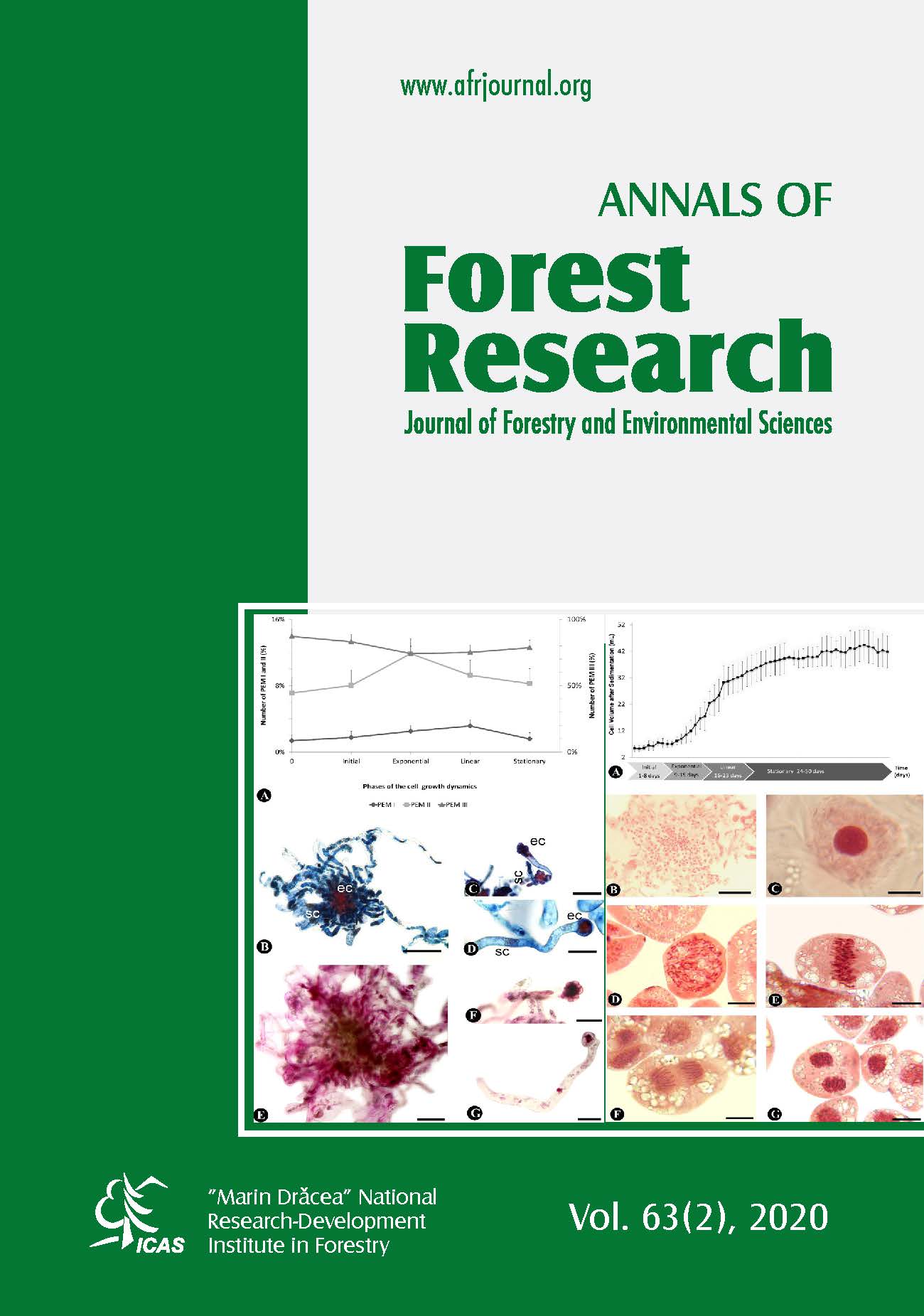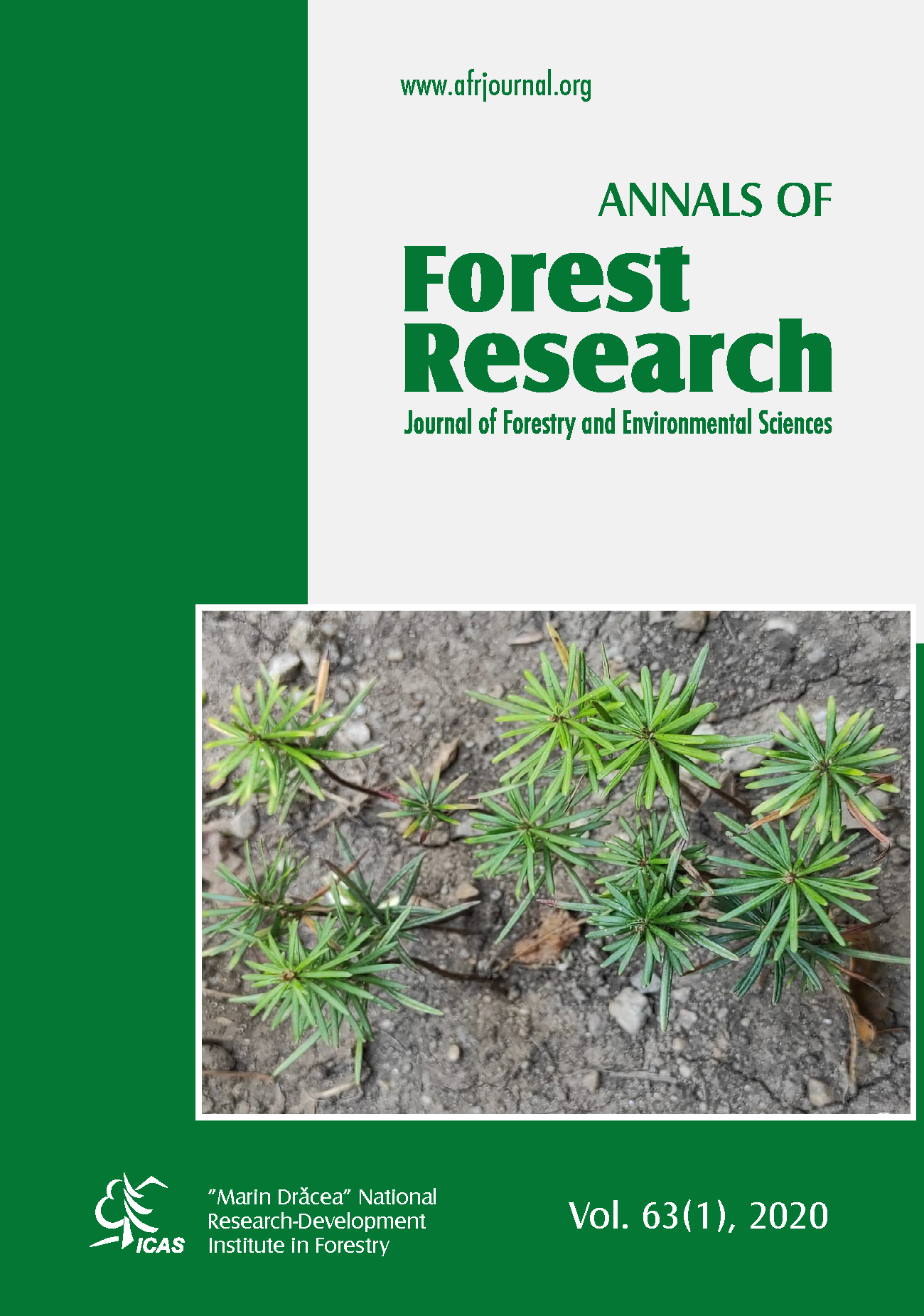Nutrient reabsorption efficiency of three tree species in Beijing plain afforestation and its C∶N∶P stoichiometry
DOI:
https://doi.org/10.15287/afr.2020.1969Keywords:
Nutrient resorption, leaf, litter, stoichiometry, Beijing plain afforestationAbstract
Elucidating variability in nutrient resorption and carbon (C), nitrogen (N) and phosphorus (P) stoichiometry is important for holistically understanding plant approaches to nutrient adaption. However, the patterns of these phenomena in afforested regions of the Beijing Plain have been ignored. Herein, we assessed patterns of leaf and litter C, N, and P stoichiometry and nutrient resorption in Robinia pseudoacacia L., Ailanthus altissima (Mill.) Swingle, and Salix matsudana Koidz. forests in afforested areas in Beijing, China. We found that the plantation growth of R. pseudoacacia and S. matsudana was mainly limited by P nutrients. Both the N and P in the fresh leaves of R. pseudoacacia were significantly higher than those in the fresh leaves of S. matsudana and A. altissima, indicating that the N resorption efficiency (NRE) of R. pseudoacacia was higher. However, the P resorption efficiency (PRE) was significantly correlated with the leaf P nutrients in the R. pseudoacacia and A. altissima forests. Except for the significant correlation between the N content of fresh leaves and the AN content in soil, there were no significant correlations between the leaf C, N and P contents and the contents of these nutrients in the soil. These results suggested that of the factors studied, leaf P stoichiometry and PRE were more responsive indicators of the afforestation area on the Beijing Plain. Together, our data indicated that P deficiency is an important factor for the forests on the Beijing Plain and that the ability of afforested areas to adapt to barren land through nutrient resorption is gradually weakened and the N and P nutrient preservation ability is reduced over time. We thus clarified the nutrient resorption and leaf P and N patterns for the three forests studied. The findings have important implications for the application of P fertilizer, which must be conducted in a timely fashion to ensure that nutrient addition meets the nutritional needs of the plants.References
Ågren G.I., 2008. Stoichiometry and nutrition of plant growth in natural communities. Annu. Rev. Ecol. Evol. Syst. 39: 153–70. https://doi.org/10.1146/annurev.ecolsys.39.110707.173515Amazonas N.T., Martinelli L.A., Marisa de C.P., Rodrigues R.R., 2011. Nitrogen dynamics during ecosystem development in tropical forest restoration. Forest Ecol. Manage. 262: 1551–1557. https://doi.org/10.1016/j.foreco.2011.07.003Boddey R.M., Peoples M.B., Palmer B., Dart P.J., 2000. Use of the 15N natural abundance technique to quantify biological nitrogen fixation by woody perennials. Nutrient Cycling in Agroecosystems 57(3): 235-270. https://doi.org/10.1023/A:1009890514844Cleveland C.C., Houlton B.Z., Smith W.K., Marklein A.R., Running S.W., 2013. Patterns of new versus recycled primary production in the terrestrial biosphere. PNAS 110: 12733–12737. https://doi.org/10.1073/pnas.1302768110Cui Y.P., Liu J.Y., Qin Y.C., Dong J.W., Zhang S.S., 2015. The impact of urban sprawl on heat island intensity in Beijing. Chinese Journal of Ecology 34 (12): 3485-3492.Du B.M., Ji H.W., Peng C., Liu X., Liu C., 2017. Altitudinal patterns of leaf stoichiometry and nutrient resorption in Quercus variabilis in the Baotianman Mountains, China. Plant Soil 413: 193–202. https://doi.org/10.1007/s11104-016-3093-9Elser J.J., Sterner R.W., Gorokhova E., Fagan W.F., Markow T.A., Cotner J.B., Harrison J.F., Hobbie S.E., Odell G.M., Weider L.W., 2010. Biological stoichiometry from genes to ecosystems. Ecol Lett 3(6): 540−550. https://doi.org/10.1046/j.1461-0248.2000.00185.xElser J.J, Acharya K., Kyle M., Makino W., Markow T., Watts T., Hobbie S., Fagan W., Schade J., 2003. Growth rate–stoichiometry couplings in diverse biota. Ecol Lett 6: 936–943. https://doi.org/10.1046/j.1461-0248.2003.00518.xGüsewell S., 2004. N:P ratios in terrestrial plants: Variation and functional significance. New Phytologist 164(2): 243-266. https://doi.org/10.1111/j.1469-8137.2004.01192.xGüsewell S., 2005. Nutrient resorption of wetland graminoids is related to the type of nutrient limitation. Funct. Ecol. 19: 344–354. https://doi.org/10.1111/j.0269-8463.2005.00967.xGyenge J., Fernández M.E., 2014. Patterns of resource use efficiency in relation to intraspecific competition, size of the trees and resource availability in ponderosa pine. Forest Ecol. Manage. 312: 231–238. https://doi.org/10.1016/j.foreco.2013.09.052Hayes P., Turner B.L., Lambers H., Laliberté E., Bellingham P., 2014. Foliar nutrient concentrations and resorption efficiency in plants of contrasting nutrient-acquisition strategies along a 2-million-year dune chronosequence. J. Ecol. 102: 396–410. https://doi.org/10.1111/1365-2745.12196Houlton B.Z., Ying P.W., Vitousek P.M., Field C.B., 2008. A unifying framework for dinitrogen fixation in the terrestrial biosphere. Nature 454: 327-330. https://doi.org/10.1038/nature07028Kobe R.K., Lepczyk C.A., Iyer M., 2005. Resorption efficiency decreases with increasing green leaf nutrients in a global data set. Ecology 86: 2780–2792. https://doi.org/10.1890/04-1830Koerselman W, Meuleman A.F.M., 1996. The vegetation N:P ration: A new tool to detect the nature of nutrient limitation. Journal of Applied Ecology 33(6): 1441-1450. https://doi.org/10.2307/2404783Killingbeck K.T., 1996. Nutrients in senesced leaves: keys to the search for potential resorption and resorption proficiency. Ecology 77: 1716–1727. https://doi.org/10.2307/2265777Liu Q.M., Wu L.J., Jia S.P., Na Z., Jing Z., Liu B., Qiang F., 2015. Effects of thinned plantation in green passageway of Beijing plain on growth of trees. Protection Forest Science and Technology 155(5): 12-15.Luyssaert S., Staelens J., De Schrijver A., 2005. Does the commonly used estimator of nutrient resorption in tree foliage actually measure what it claims to? Oecologia 144: 177–186. https://doi.org/10.1007/s00442-005-0085-5Paul K.I., Polglase P.J., Nyakuengama J.G., Khanna P.K., 2002. Change in soil carbon following afforestation. Forest Ecol. Manage. 168(1-3): 241-257. https://doi.org/10.1016/S0378-1127(01)00740-XPugnaire F.I., Chapin III F.S., 1993. Controls over nutrient resorption from leaves of evergreen Mediterranean species. Ecology 74(1): 124−129. https://doi.org/10.2307/1939507Reich P.B., Oleksyn J., 2004. Global patterns of plant leaf N and P in relation to temperature and latitude. Proceedings of the National Academy of Sciences of the United States of America, 101(30): 11001−11006. https://doi.org/10.1073/pnas.0403588101Rejmánková E., 2005. Nutrient resorption in wetland macrophytes: comparison across several regions of different nutrient status. New Phytol. 167: 471–482. https://doi.org/10.1111/j.1469-8137.2005.01449.xReed S.C., Townsend A.R., Davidson E.A., Cleveland C.C., 2012. Stoichiometric patterns in foliar nutrient resorption across multiple scales. New Phytol. 196: 173–180. https://doi.org/10.1111/j.1469-8137.2012.04249.xSchreeg L.A., Santiago L.S., Wright S.J., Turner B.L., 2014. Stem, root, and older leaf N:P ratios are more responsive indicators of soil nutrient availability than new foliage. Ecology 95: 2062–2068. https://doi.org/10.1890/13-1671.1Sterner R.W., Elser J.J., 2002. Ecological stoichiometry: The biology of elements from molecules to the biosphere [M]. Princeton, N.J.: Princeton University Press.Sun Z.Z., Liu L.L., Peng S.S., 2016. Age-related modulation of the nitrogen resorption efficiency response to growth requirements and soil nitrogen availability in a temperate pine plantation. Ecosystems 19: 698–709. https://doi.org/10.1007/s10021-016-9962-5Tessier J.T., Raynal D.J., 2003. Use of nitrogen to phosphorus ratios in plant tissue as an indicator of nutrient limitation and nitrogen saturation. Journal of Applied Ecology 40: 523-534. https://doi.org/10.1046/j.1365-2664.2003.00820.xVergutz L., Manzoni S., Porporato A., Novais R.F., Jackson R.B., 2012. Global resorption efficiencies and concentrations of carbon and nutrients in leaves of terrestrial plants. Ecol. Monogr 82: 205–220. https://doi.org/10.1890/11-0416.1Vitousek P.M., 2003. Stoichiometry and flexibility in the Hawaiian model system. In: Melillo J.M., Field C.B., Moldan B. (eds.) Scope 61: Interactions of the major biogeochemical cycles: global change and human impacts. Washington DC: Island Press: 117-134.Vitousek P.M., Turner D.R., Parton W.J., Sanford R.L., 1994. Litter decomposition on the Mauna Loa environmental matrix, Hawai’i: patterns, mechanisms, and models. Ecology 75(2): 418−429. https://doi.org/10.2307/1939545Wang C., Jia B.Q., Qie G.F., 2017. Effect and development countermeasures of Beijing plain afforestation. Journal of Chinese Urban Forestry 15(06): 6-11.Wang Z., Lu J., Yang M., Yang H., Zhang Q., 2015. Stoichiometric characteristics of carbon, nitrogen, and phosphorus in leaves of differently aged Lucerne (Medicago sativa) stands. Front. Plant Sci. 6, 1062. https://doi.org/10.3389/fpls.2015.01062Yan B.G., Liu G.C., Fan B., 2015. Relationships between plant stoichiometry and biomass in an arid-hot valley, Southwest China. Chinese Journal of Plant Ecology 39(8): 807−815.Yan T., Lü X.T., Zhu J.J., Yang K., Yu L.Z., Gao T., 2017. Changes in nitrogen and phosphorus cycling suggest a transition to phosphorus limitation with the stand development of larch plantations. Plant Soil 422: 385–396.Zhang L., Yan E.R., Wei H.X., 2014. Leaf nitrogen resorption proficiency of seven shrubs across timberline ecotones in the Sergymla Mountains, Southeast Xizang. Chinese Journal of Plant Ecology 38(12): 1325−1332.Yao Z., Baitian W., Meng, L.I., Xu H.W., Xiu Q.D., 2018. Ecological stoichiometric characteristics of carbon, nitrogen, and phosphorus in three forests in the Lüliang Mountainous Area of Shanxi Province. Chinese Journal of Applied and Environmental Biology 24(3): 518−524.Zheng Y.L., Wang H.Y., Xie Y.L., Li X., 2018. Effect of tree species on soil fertility quality in plain afforestation area, Beijing. Science of Soil and Water Conservation 16(06): 89-98.Zhu J.T., Li X.Y., Zhang X.M., Lin L.S., Yang S.G., 2010. Nitrogen allocation and partitioning within a leguminous and two non-leguminous plant species growing at the southern fringe of China’s Taklamakan Desert. Chinese Journal of Plant Ecology 34(9): 1025−1032. DOI: 10.3773/j.issn.1005-264x.2010.09.003
Downloads
Published
Issue
Section
License
All the papers published in Annals of Forest Research are available under an open access policy (Gratis Gold Open Access Licence), which guaranty the free (of taxes) and unlimited access, for anyone, to entire content of the all published articles. The users are free to “read, copy, distribute, print, search or refers to the full text of these articles”, as long they mention the source.
The other materials (texts, images, graphical elements presented on the Website) are protected by copyright.
The journal exerts a permanent quality check, based on an established protocol for publishing the manuscripts. The potential article to be published are evaluated (peer-review) by members of the Editorial Board or other collaborators with competences on the paper topics. The publishing of manuscript is free of charge, all the costs being supported by Forest Research and Management Institute.
More details about Open Access:
Wikipedia: http://en.wikipedia.org/wiki/Open_access





